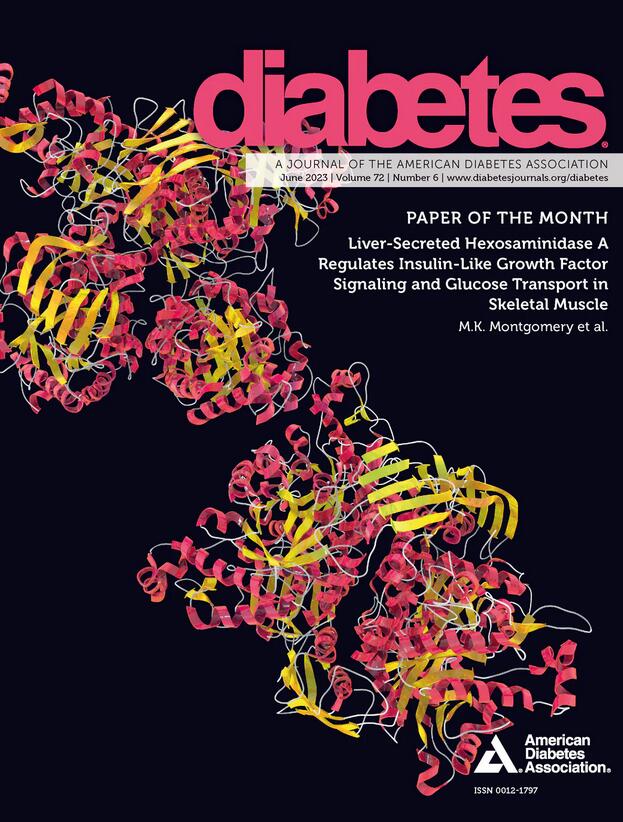胰高血糖素受体缺乏导致早发性肝脂肪变性
IF 7.5
1区 医学
Q1 ENDOCRINOLOGY & METABOLISM
引用次数: 0
摘要
在小鼠中,胰高血糖素通过激活肝脏中的受体调节脂质代谢;然而,其在人体脂质代谢中的作用尚不完全清楚。在这里,我们描述了三个正常体重的人从一个近亲家庭与早发性肝脂肪变性和/或肝硬化。通过外显子组测序,我们发现它们在胰高血糖素受体基因(GCGR)中有两个错义变异是纯合的。在细胞中,双GCGR突变减少了细胞膜的表达和信号传导,导致功能几乎完全丧失。致病性GCGR突变携带者的循环胰高血糖素和氨基酸水平显著升高,肥胖增加。将双GCGR突变通过聚集规律间隔的短回文重复序列([CRISPR]/CRISPR相关蛋白9)导入人诱导的多能干细胞来源的肝细胞,导致脂质积累增加。我们的研究结果为GCGR拮抗剂临床试验中肝脂肪增加和GCGR激动剂治疗的肥胖和脂肪变性肝病患者肝脂肪减少提供了解释。在这项研究中,我们调查了一个近亲家庭,其中体重正常的个体患有肝脂肪变性和肝硬化。利用全外显子组测序,我们在胰高血糖素受体(GCGR)基因中发现了两个罕见的与表型共分离的纯合变异。在细胞中,GCGR突变导致功能丧失和脂质积累增加。这些结果强调了目前处于临床试验中的GCGR拮抗剂的潜在风险和GCGR激动剂的益处。本文章由计算机程序翻译,如有差异,请以英文原文为准。
Glucagon Receptor Deficiency Causes Early-Onset Hepatic Steatosis
In mice, glucagon regulates lipid metabolism by activating receptors in the liver; however, its role in human lipid metabolism is incompletely understood. Here we describe three normal-weight individuals from a consanguineous family with early-onset hepatic steatosis and/or cirrhosis. Using exome sequencing, we found they were homozygous for two missense variants in the glucagon receptor gene (GCGR). In cells, the double GCGR mutation reduced cell membrane expression and signaling, resulting in an almost complete loss of function. Carriers of pathogenic GCGR mutations had substantially elevated circulating glucagon and amino acid levels and increased adiposity. Introducing the double GCGR mutation into human-induced pluripotent stem cell–derived hepatocytes using clustered regularly interspaced short palindromic repeats ([CRISPR]/CRISPR-associated protein 9) caused increased lipid accumulation. Our results provide an explanation for increased liver fat seen in clinical trials of GCGR antagonists and reduced liver fat in people with obesity and steatotic liver disease treated with GCGR agonists. ARTICLE HIGHLIGHTS In this study, we investigated a consanguineous family in whom normal-weight individuals had hepatic steatosis and cirrhosis. Using whole-exome sequencing we found two rare homozygous variants in the glucagon receptor (GCGR) gene that cosegregated with the phenotype. In cells, the GCGR mutations result in a loss of function and increased lipid accumulation. These results highlight the potential risks associated with GCGR antagonists and the benefits of GCGR agonists, currently in clinical trials.
求助全文
通过发布文献求助,成功后即可免费获取论文全文。
去求助
来源期刊

Diabetes
医学-内分泌学与代谢
CiteScore
12.50
自引率
2.60%
发文量
1968
审稿时长
1 months
期刊介绍:
Diabetes is a scientific journal that publishes original research exploring the physiological and pathophysiological aspects of diabetes mellitus. We encourage submissions of manuscripts pertaining to laboratory, animal, or human research, covering a wide range of topics. Our primary focus is on investigative reports investigating various aspects such as the development and progression of diabetes, along with its associated complications. We also welcome studies delving into normal and pathological pancreatic islet function and intermediary metabolism, as well as exploring the mechanisms of drug and hormone action from a pharmacological perspective. Additionally, we encourage submissions that delve into the biochemical and molecular aspects of both normal and abnormal biological processes.
However, it is important to note that we do not publish studies relating to diabetes education or the application of accepted therapeutic and diagnostic approaches to patients with diabetes mellitus. Our aim is to provide a platform for research that contributes to advancing our understanding of the underlying mechanisms and processes of diabetes.
 求助内容:
求助内容: 应助结果提醒方式:
应助结果提醒方式:


